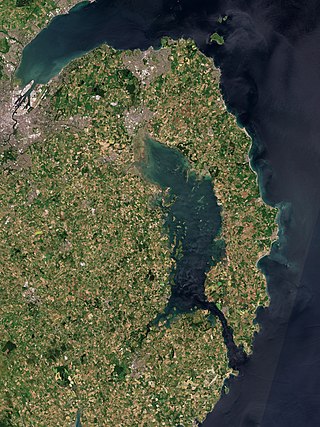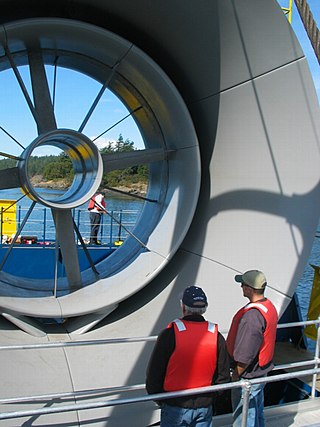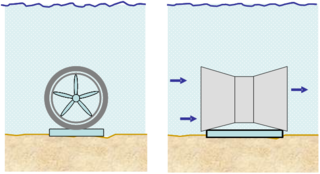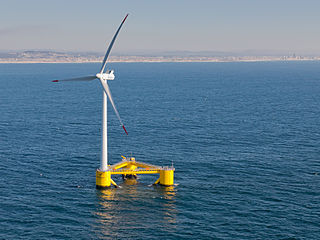
Strangford Lough is a large sea lough or inlet in County Down, in the east of Northern Ireland. It is the largest inlet in Ireland and the wider British Isles, covering 150 km2 (58 sq mi). The lough is almost fully enclosed by the Ards Peninsula and is linked to the Irish Sea by a long narrow channel at its southeastern edge. The main body of the lough has at least seventy islands along with many islets (pladdies), bays, coves, headlands and mudflats. It is part of the Strangford and Lecale Area of Outstanding Natural Beauty. Strangford Lough was designated as Northern Ireland's first Marine Conservation Zone in 2013, and has been designated a Special Area of Conservation for its important wildlife.

Wave power is the capture of energy of wind waves to do useful work – for example, electricity generation, water desalination, or pumping water. A machine that exploits wave power is a wave energy converter (WEC).
Marine currents can carry large amounts of water, largely driven by the tides, which are a consequence of the gravitational effects of the planetary motion of the Earth, the Moon and the Sun. Augmented flow velocities can be found where the underwater topography in straits between islands and the mainland or in shallows around headlands plays a major role in enhancing the flow velocities, resulting in appreciable kinetic energy. The Sun acts as the primary driving force, causing winds and temperature differences. Because there are only small fluctuations in current speed and stream location with minimal changes in direction, ocean currents may be suitable locations for deploying energy extraction devices such as turbines. Other effects such as regional differences in temperature and salinity and the Coriolis effect due to the rotation of the earth are also major influences. The kinetic energy of marine currents can be converted in much the same way that a wind turbine extracts energy from the wind, using various types of open-flow rotors.
An OE Buoy or Ocean Energy Buoy is a floating wave power device that uses an Oscillating Water Column design. It is being developed by Irish company Ocean Energy Ltd., based in Cork, in collaboration with the Hydraulics and Maritime Research Centre at University College Cork, Queen's University Belfast, and Marine Institute Ireland.
The Wave Hub is an offshore renewable energy research project, originally developed for wave power, but following limited interest is being developed for floating offshore wind. The project is developed approximately 10 miles (16 km) off Hayle, on the north coast of Cornwall, United Kingdom.

CETO is a wave-energy technology that converts kinetic energy from ocean swell into electrical power and directly desalinates freshwater through reverse osmosis. The technology was developed and tested onshore and offshore in Fremantle, Western Australia. In early 2015 a CETO 5 production installation was commissioned and connected to the grid. As of January 2016 all the electricity generated is being purchased to contribute towards the power requirements of HMAS Stirling naval base at Garden Island, Western Australia. Some of the energy will also be used directly to desalinate water.

The European Marine Energy Centre (EMEC) Ltd. is a UKAS accredited test and research centre focused on wave and tidal power development, based in the Orkney Islands, UK. The centre provides developers with the opportunity to test full-scale grid-connected prototype devices in wave and tidal conditions, at pre-consented test sites. EMEC also has sites for testing smaller-scale prototypes in more sheltered conditions.
Marine Current Turbines Ltd (MCT), was a United Kingdom-based company that developed tidal stream generators, most notably the 1.2 MW SeaGen turbine. The company was bought by the German automation company, Siemens in 2012, who later sold the company to Atlantis Resources in 2015.

The shrouded tidal turbine is an emerging tidal stream technology that has a turbine enclosed in a venturi shaped shroud or duct (ventuduct), producing a sub atmosphere of low pressure behind the turbine. The venturi shrouded turbine is not subject to the Betz limit and allows the turbine to operate at higher efficiencies than the turbine alone by increasing the volume of the flow over the turbine. Claimed improvements vary, from 1.15 to 4 times higher power output than the same turbine minus the shroud. The Betz limit of 59.3% conversion efficiency for a turbine in an open flow still applies, but is applied to the much larger shroud cross-section rather than the small turbine cross-section.
The Oyster was a hydro-electric wave energy device that used the motion of ocean waves to generate electricity. It was made up of a Power Connector Frame (PCF), which is bolted to the seabed, and a Power Capture Unit (PCU). The PCU is a hinged buoyant flap that moves back and forth with movement of the waves. The movement of the flap drives two hydraulic pistons that feed high-pressured water to an onshore hydro-electric turbine, which drives a generator to make electricity. Oyster was stationed at the European Marine Energy Centre (EMEC) at its Billia Croo site in Orkney, Scotland until the company ceased trading in 2015.

Marine energy or marine power refers to the energy carried by ocean waves, tides, salinity, and ocean temperature differences. The movement of water in the world's oceans creates a vast store of kinetic energy, or energy in motion. Some of this energy can be harnessed to generate electricity to power homes, transport and industries.

A tidal farm is a group of tidal stream generators used for production of electric power. The potential of tidal farms is limited by the number of suitable sites across the globe as there are niche requirements to make a tidal farm cost effective and environmentally conscious.

A tidal stream generator, often referred to as a tidal energy converter (TEC), is a machine that extracts energy from moving masses of water, in particular tides, although the term is often used in reference to machines designed to extract energy from the run of a river or tidal estuarine sites. Certain types of these machines function very much like underwater wind turbines and are thus often referred to as tidal turbines. They were first conceived in the 1970s during the oil crisis.
Oscillating water columns (OWCs) are a type of wave energy converter that harness energy from the oscillation of the seawater inside a chamber or hollow caused by the action of waves. OWCs have shown promise as a renewable energy source with low environmental impact. Because of this, multiple companies have been working to design increasingly efficient OWC models. OWC are devices with a semi-submerged chamber or hollow open to the sea below, keeping a trapped air pocket above a water column. Waves force the column to act like a piston, moving up and down, forcing the air out of the chamber and back into it. This continuous movement forces a bidirectional stream of high-velocity air, which is channeled through a power take-off (PTO). The PTO system converts the airflow into energy. In models that convert airflow to electricity, the PTO system consists of a bidirectional turbine. This means that the turbine always spins the same direction regardless of the direction of airflow, allowing for energy to be continuously generated. Both the collecting chamber and PTO systems will be explained further under "Basic OWC Components."

Orbital Marine Power is a Scottish renewable energy company focused on the development and global deployment of its pioneering floating turbine technology. The O2 is Orbital's first commercial turbine and represents the culmination of more than 15 years of world leading product development in the UK. The 74 m long turbine is expected to operate in the waters off Orkney for the next 15–20 years with the capacity to meet the annual electricity demand of around 2,000 UK homes with clean, predictable power from the fast-flowing waters while offsetting approximately 2,200 tonnes of CO2 production per year. In a further ground-breaking element of the project, the O2 will provide power to the European Marine Energy Centre's onshore electrolyser to generate green hydrogen that will be used to demonstrate decarbonisation of wider energy requirements.
Many tidal stream generators have been developed over the years to harness the power of tidal currents flowing around coastlines. These are also called tidal stream turbines (TST), tidal energy converters (TEC), or marine hydro-kinetic (MHK) generation. These turbines operate on a similar principle to wind turbines, but are designed to work in a fluid approximately 800 times more dense than air which is moving at a slower velocity. Note that tidal barrages or lagoons operate on a different principle, generating power by impounding the rising and falling tide.

OpenHydro Group Ltd was an Irish developer of tidal stream turbines, established in 2004. It was acquired by Naval Energies in 2013, however, Naval Energies decided in July 2018 to stop developing tidal turbines and focus on floating wind turbines. The company subsequently went into liquidation with debts of about €280m.

The Aguçadoura test site is an offshore location in the north of Portugal where grid connected offshore renewable energy devices have been tested, for research and project demonstration. It is about 5 km (3 miles) off the coast of Aguçadoura, Póvoa de Varzim, about 35 km NNE of central Porto.
Magallanes Renovables, S.L. is a Spanish developer of floating tidal stream energy devices, set up in 2009. The company's head office is in Redondela, Galicia, with a UK subsidiary Magallanes Tidal Energy Ltd. based in Kirkwall.














